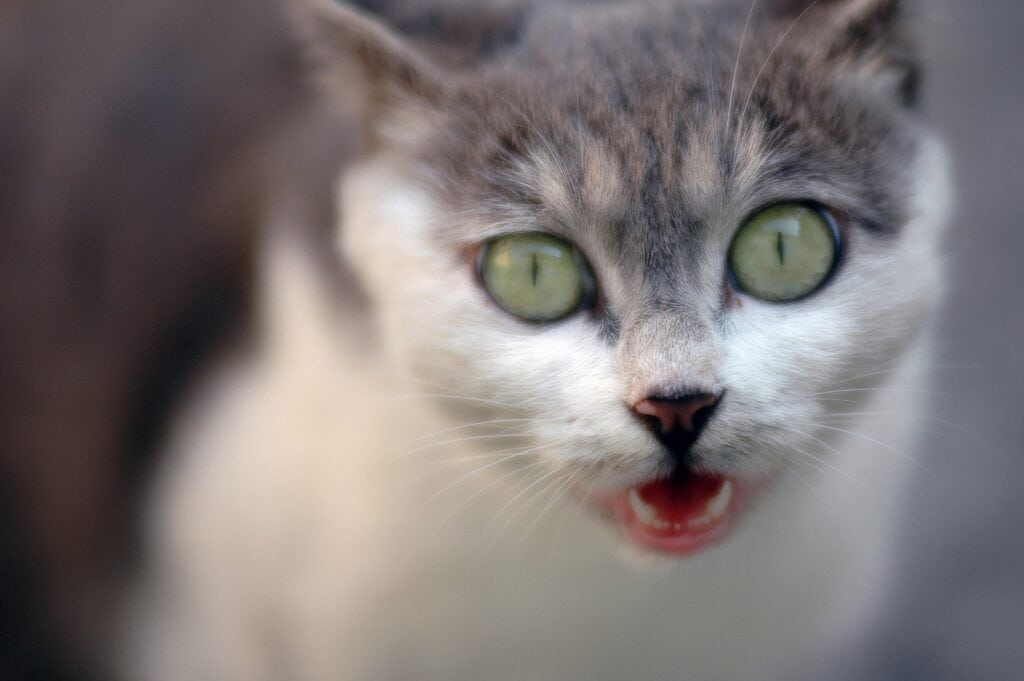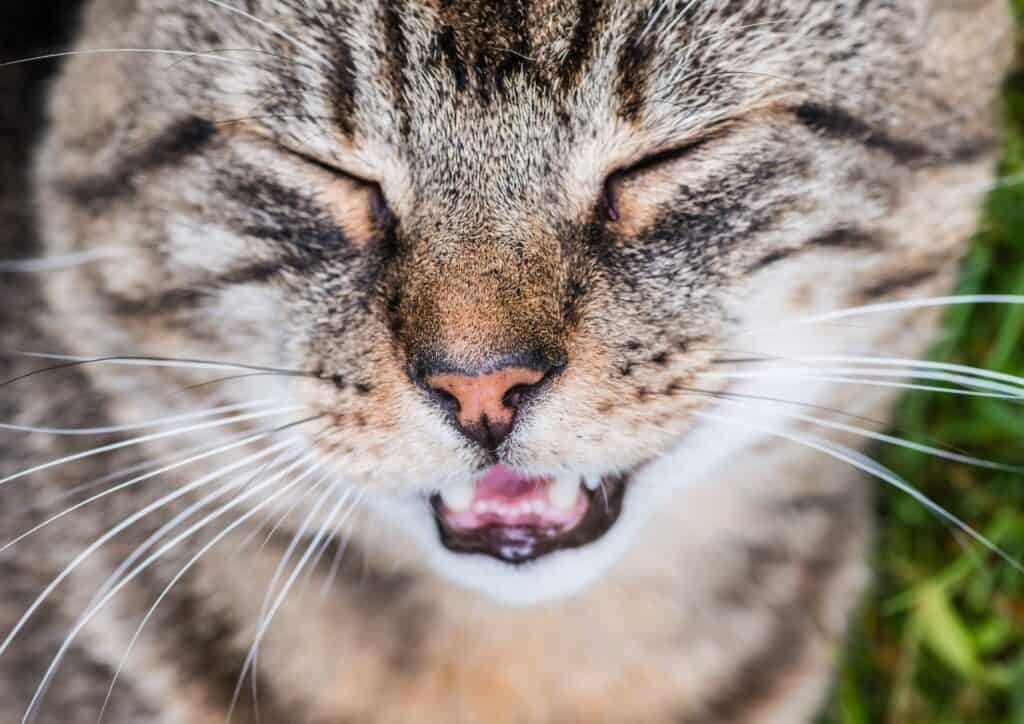Wheezing in cats is a symptom that pet owners should never ignore. Wheezing is not normal for a healthy cat and can indicate various health issues, from allergies and asthma to serious conditions like cancer or heart disease.
If your cat is wheezing, it’s important to understand the causes and when to seek veterinary care.
In this guide, we will explore feline wheezing, including its potential causes, the importance of timely diagnosis, and available treatment options.
Read on to learn how you can better ensure the health and well-being of your feline friend.
“My Cat Is Wheezing” – What Does That Mean?
Wheezing in cats is characterized by a distinct sound that is different from coughing or choking. It usually sounds like a huffing or whistling noise when the cat breathes in or out. This sound can also be described as a slight musical rattling of the breath.
In contrast, coughing typically involves a forceful expulsion of air from the lungs, often accompanied by a guttural sound, while choking is marked by gagging and struggling to breathe.
Wheezing in cats is a continuous and consistent sound associated with breathing difficulties, rather than a sudden or violent expulsion of air or a reaction to an obstruction in the throat.
The severity of wheezing in cats can greatly vary and can range from mild to severe. It should not be taken lightly, since even mild instances of wheezing can escalate if not given appropriate attention.
A cat with severe wheezing often takes on a specific posture to help itself breathe better. This includes hunching its shoulders and stretching its neck forward or upward. By doing so, the cat can elongate its airways, which may provide some relief.
The cat may appear tense or strained in this position as it tries to breathe despite the difficulty. This posture is a response to the discomfort or distress caused by the restricted airflow associated with wheezing.
In severe cases, the constant struggle to breathe can lead to fatigue, decreased appetite, and a noticeable decline in physical activity.
Causes of Cat Wheezing
Understanding the causes of wheezing in cats is an important step to evaluating the risk to their health and can help determine the right treatment. This knowledge will empower cat owners to identify potential triggers and seek prompt veterinary care when necessary.
While we have categorized these causes as “mild”, “moderate”, and “severe”, it is important to note that these categories apply to cats in general. However, it is worth mentioning that individual cats may exhibit variations in their wheezing severity, which may be either less or more pronounced than what is typically expected.
Mild Causes of Wheezing
Hairballs
Cats groom themselves, swallowing a lot of their fur in the process. Usually, this fur passes through their feces without any issues. However, some cats can’t expel all the hair, leading to accumulation in the digestive tract.
This accumulation forms a hairball, causing stomach irritation and vomiting. Cats may make wheezing sounds while trying to vomit the hairball, but it’s not true wheezing and stops after the hairball is passed.
Allergies
Pets with allergies, whether it’s food allergies, environmental allergies (e.g., pollen or dust mites), or contact allergies, may experience wheezing as one of their symptoms.
Wheezing can result from inflammation and narrowing of the airways that can occur during an allergic reaction, making it harder for pets to breathe when exposed to allergens.
Facial Conformation
Persian cats and other brachycephalic breeds, with their flat faces and shortened muzzles, are prone to breathing difficulties due to the shape of their airways.
The structure of a short muzzle nose creates a small space for air to enter and exit, impeding normal airflow and leading to wheezing.
In most cases, this type of wheezing is harmless and may not require medical intervention unless it becomes severe.
Moderate Causes of Wheezing
Respiratory Infection
Wheezing can occur in cats with respiratory infections such as a feline upper respiratory infection. This includes viral infection as well as bacterial infection. Fungal infections, though less common, can also occur. Infections can lead to inflammation and excess mucus production in the airways, resulting in wheezing as the pet struggles to breathe normally.
Asthma Attack
Feline asthma (also known as allergic bronchitis) is one of the more common causes of wheezing in cats. It causes chronic inflammation and constriction of the respiratory tract, triggering wheezing episodes.

Severe Causes of Wheezing
Heartworms
Although less common in cats than in dogs, heartworm disease is a serious condition that can cause wheezing in cats. When heartworms are present in the heart and pulmonary arteries, they can cause significant damage, resulting in heart and lung issues. This compromised respiratory function can lead to wheezing.
Airway Blockage
When cats experience an airway blockage, such as from foreign objects, tumors, or severe swelling, wheezing can be a prominent symptom. An obstruction in the airway causes air to struggle to pass through, creating wheezing sounds as the cat breathes.
Cancer
When cancer affects the respiratory system or nearby tissues, wheezing can occur. Tumors or growths in the airways or lungs can block airflow, causing wheezing as the cat tries to breathe.
Heart Disease
Some forms of heart disease, particularly congestive heart failure (CHF), can cause fluid accumulation in the lungs (pulmonary edema), which can lead to wheezing as the cat tries to breathe.
When to Seek Veterinary Care
Although mild cases of wheezing may not require immediate veterinary attention, it’s essential to monitor your cat’s condition and seek prompt care if symptoms persist, worsen, or are accompanied by other concerning signs.
Symptoms Requiring Immediate Medical Attention
- Severe Wheezing: If your pet experiences intense and continuous wheezing, especially if accompanied by labored breathing or cyanosis (blue or pale gums), this is a clear sign of distress. Difficulty breathing always requires immediate veterinary attention.
- Rapid Breathing: If your cat is breathing rapidly, it may be struggling to get enough oxygen.
- Choking or Gagging: If your pet is coughing, choking, or gagging in addition to wheezing, it could indicate an airway obstruction and prompt action is critical.
- Sudden Onset: If wheezing suddenly appears without any apparent cause, it may indicate a serious problem like an allergic reaction or anaphylaxis, which demands immediate attention.
- Weakness or Collapse: If your pet becomes weak, collapses, or loses consciousness along with wheezing, it may indicate a severe respiratory or cardiac issue, requiring immediate emergency care.
- Bleeding: If wheezing is accompanied by coughing up blood or bleeding from the nose or mouth, it’s a serious concern and needs immediate veterinary evaluation.
Signs of a More Serious Underlying Condition
- Frequent Wheezing: Persistent or recurring wheezing, even if it seems mild, can be a sign of an underlying respiratory issue, especially in cats with a history of respiratory problems like asthma or chronic bronchitis.
- Weight Loss or Loss of Appetite: If wheezing is accompanied by weight loss, reduced appetite, or lethargy, it may indicate a more severe condition, such as cancer or chronic illness.
- Change in Behavior: Any significant change in your cat’s behavior, such as increased restlessness, discomfort, or irritability, along with wheezing, should be taken seriously.
Even cats with mild cases of wheezing should be examined by a veterinarian as soon as is reasonably possible. Early diagnosis and treatment of the underlying cause can help prevent a mild case of wheezing from turning into a life-threatening emergency.
Diagnosis and Treatment
A thorough physical examination, including assessing your cat’s breathing and listening to their lungs with a stethoscope, will help your veterinarian determine the cause of wheezing.
Your veterinarian will inquire about the cat’s medical history, including any previous respiratory issues, allergies, or recent exposure to potential irritants. They will also look for other signs of illness in your cat.
Depending on the suspected underlying condition, your veterinarian may recommend additional diagnostic tests, which can include:
- Chest X-ray: To assess the condition of your cat’s lungs and check for any abnormalities or masses.
- Blood Tests: To evaluate overall health, assess for signs of infection, or check for underlying diseases.
- Bronchoscopy: In some cases, a small camera may be used to examine the airways for obstructions or abnormalities.
- Allergy Testing: If allergies are suspected, allergy testing may be conducted to identify specific allergens triggering the wheezing.
The treatment of wheezing in cats depends on the underlying cause identified during the diagnostic process. Treatment options may include:
Allergies: If allergies are the cause of wheezing, your veterinarian may recommend allergen avoidance strategies, antihistamines, corticosteroids, or immunotherapy (allergy shots) to manage symptoms.
Respiratory Infections: Bacterial or viral respiratory infections may require antibiotics or antiviral medications, as well as supportive care such as fluid therapy and nebulization.
Asthma: For cats with asthma, bronchodilators and corticosteroids are often prescribed to reduce airway inflammation and alleviate wheezing. In a severe asthma attack, oxygen therapy may be necessary.
Heartworm Disease: Treatment for heartworm disease in cats can be challenging, and it may involve medications to manage symptoms and address complications.
Tumors or Airway Blockages: Surgical removal of tumors or foreign bodies may be necessary to clear airway obstructions. This often requires specialized procedures.
Chronic Conditions: In cases of chronic conditions like chronic bronchitis or congestive heart failure, long-term management with medications and lifestyle changes may be necessary.

Preventative Measures and Management
Once your cat has been to the veterinarian and received a diagnosis and treatment plan, it’s important to follow through with any recommended treatments and monitoring by your veterinarian.
This includes:
- Administer medications as prescribed and adhere to recommended dosages.
- Monitor your cat’s response to treatment and report any changes or concerns promptly to your veterinarian.
- Follow up with scheduled veterinary appointments for reevaluation and adjustments to the treatment plan if needed.
- Create a safe and comfortable environment for your cat, especially if they have chronic respiratory issues or allergies.
- Be proactive in managing potential triggers and risks, such as avoiding smoke, fragrances, or other irritants.
While some causes of wheezing, such as congenital or hereditary conditions, may not be preventable, there are steps you can take to minimize the risk of respiratory issues in your cat:
- Avoid Secondhand Smoke: Just like humans, cats can develop respiratory problems from exposure to secondhand smoke. Avoid smoking near your pet and keep them away from areas where others may be smoking.
- Minimize Exposure to Environmental Allergens: If your cat has known or suspected allergies, try to reduce their exposure to potential triggers like pollen, dust, mold, and other common irritants. Using hepa filters and regular cleaning of your cat’s environment will help reduce allergens indoors.
- Keep Your Cat Indoors: Outdoor cats are more exposed to pollutants, toxins, and infectious agents that can lead to respiratory problems. Keeping your cat indoors can help minimize these risks.
- Monitor Your Cat’s Weight: Obesity is a risk factor for several health issues, including respiratory problems. Keep your cat at a healthy weight through proper diet and exercise to reduce their chances of developing wheezing or other health concerns.
- Regular Veterinary Check-Ups: Regular wellness exams allow your veterinarian to monitor your cat’s overall health and catch any potential issues early on, including respiratory problems.
Conclusion
If you are asking “why my cat is wheezing”, then you should be contacting a veterinarian right away. Wheezing in cats is a symptom that should not be overlooked. It can be associated with a variety of underlying conditions, some of which are potentially life-threatening.
Early recognition, prompt veterinary consultation, and following the vet’s medical advice are necessary for managing this symptom and protecting the health of your cat.
While some causes may be unavoidable, efforts can be made to minimize the risk of respiratory problems, such as avoiding second-hand smoke, reducing exposure to allergens, keeping your cat indoors, and maintaining regular veterinary check-ups.
So, don’t delay in seeking veterinary care if your cat is experiencing wheezing or any other respiratory symptoms. Your cat’s health and well-being are worth it!
Disclaimer: This article is intended for informational purposes only, and does not constitute medical advice. Always consult your veterinarian if you have specific concerns about your pet’s health.
Sources
- https://www.healthline.com/health/allergies/can-allergies-cause-wheezing
- https://www.fda.gov/animal-veterinary/animal-health-literacy/keep-worms-out-your-pets-heart-facts-about-heartworm-disease
- https://www.merckvetmanual.com/respiratory-system/respiratory-diseases-of-small-animals/feline-respiratory-disease-complex
- www.heartfailurematters.org/understanding-heart-failure/coughing-or-wheezing

